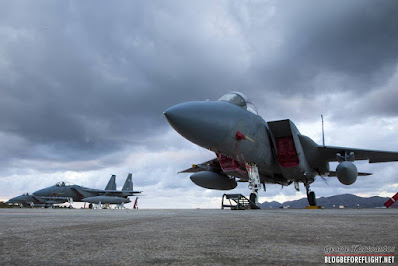Saudi Arabia, Greece join forces for Falcon Eye 1 exercise in East Med
 |
| Royal Saudi Air Force F-15C fighters ready to take off from Souda Bay Air Base, Crete, for a mission as part of the Falcon Eye 1 exercise. |
In mid-March, the Royal Saudi Air Force (RSAF) deployed six F-15C fighters at Souda Bay Air Base on the Greek island of Crete to take part in a joint exercise with the Hellenic Air Force (HAF). The exercise, called Falcon Eye 1, marks the first major joint air drill between the two nations.
Col. Abdulrahman Al-Shehri, commander of the RSAF detatchment said the exerise is “exceptional and the first of its kind with the Greek Air Force to refine and develop the technical skills of the air crew, and to support their readiness to exchange experiences in all available fields.”
During Falcon Eye 1, which will likely last until the end of March, Saudi aircraft are training alongside Greek F-16, Mirage 2000 and F-4 Phantom fighters in air defense, close air support and ground attack activities on mainland and the Mediterranean Sea.
It is no secret that Athens is looking for allies against its archenemy. In recent years, the presence of combat aircraft from friendly nations has intensified considerably in Crete. Greece and Turkey have been in conflict for a long time now, the most recent disputes being related to their overlapping interests in gas-rich areas in the eastern Mediterranean. This expansionist aim of Turkey also worries other nations, such as France, which last summer deployed Rafale fighters in Crete to monitor the area.
During Falcon Eye 1, which will likely last until the end of March, Saudi aircraft are training alongside Greek F-16, Mirage 2000 and F-4 Phantom fighters in air defense, close air support and ground attack activities on mainland and the Mediterranean Sea.
According to the Greek Chief of Staff, Lt. Gen. Konstantinos Floros, the primary purpose of the exercise is “to exchange the military expertise between the Kingdom of Saudi Arabia and Greece in order to support bonds of cooperation between the forces of the two countries which will contribute to raising the level of the combat readiness for both forces.”
The announcement earlier this year of the Falcon Eye 1 immediately caused discontent in Turkey. Turkish President Recep Tayyip Erdogan has seen it as an alliance pact between Greece and Saudi Arabia against Turkey. However, he believes this is a 'temporary mistake' by Riyadh, noting that the Arab nation has recently expressed a desire to purchase Turkish-made armed drones. On the other hand, Saudi Arabia appears to have denied its interest in such systems.
It is no secret that Athens is looking for allies against its archenemy. In recent years, the presence of combat aircraft from friendly nations has intensified considerably in Crete. Greece and Turkey have been in conflict for a long time now, the most recent disputes being related to their overlapping interests in gas-rich areas in the eastern Mediterranean. This expansionist aim of Turkey also worries other nations, such as France, which last summer deployed Rafale fighters in Crete to monitor the area.
“The particularly important presence of the Saudi Armed Forces in Souda is added to, among others, those of the United Arab Emirates, France, the USA and [Greek] Cyprus and highlights the important role of Crete in consolidating security and stability in the wider region of the Central and Eastern Mediterranean as well as the Middle East,” said a Hellenic National Defense General Staff statement.
In the past few months, a lot of news has been published about this tutorial, some of which are quite funny. Arab media said that during Falcon Eye 1 some RSAF pilots would fly Greek fighters. It is nonsense, however, as Saudi Arabian officers are not trained to fly HAF aircraft, they may eventually sit in the back. The RSAF combat fleet consists of F-15s and Eurofighters, and neither type is operated from Greece.
Saudi Arabia is well known for being one of the largest F-15 users in the world with a fleet of around 220 jets split between the Eagle and Strike Eagle variants, most of which are currently undergoing upgrades.
Falcon Eye 1 is just the first of several training activities that the HAF is planning to conduct with its allies in the Med.
Written by Matteo Sanzani
Photo Credit: George Karavantos















No comments
All comments related to the contents of our articles are welcome. It is not allowed to post promotional messages, links to external sites, or references to activities not related to this blog.